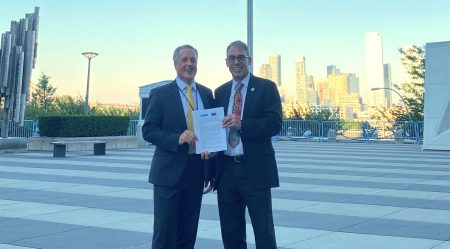Mapping a data-driven Europe
Providers of official national geographic information have pledged to continue their Europe-wide cooperation to underpin the data infrastructures that enable a sustainable, safer, and prosperous society.
Leaders participating in the General Assembly of EuroGeographics, the not-for-profit association for Europe’s National Mapping, Cadastral and Land Registration Authorities, focussed their discussions on the user requirements that will form the foundation for future collaborations and realise a wide range of policies, including the EU’s Digital Decade and Green Deal.
Speaking at the annual meeting, Cristian Bușoi, MEP and Chair of the Committee on Industry, Research and Energy said: “Every data producer in the world, especially public data providers, must ensure that their data is ready to underpin this decade of action.”
“This is an immense responsibility for EuroGeographics and its members in ensuring that the data meets the needs and requirements of European Union's institutions and supports them in addressing the challenges they are facing. The quality of the data is utterly important – authoritative data that comes from official sources is crucial for decision makers. I'm confident that EuroGeographics members will help build this data driven society, and we encourage them to enhance the existing data infrastructure and support the creation of pan-European datasets.”
Knowing where to find and access accurate, high quality, reliable high-value data is essential for governments and decision-makers making critical decisions. The European Institutions already have access to the only official pan-European geospatial datasets created by harmonising EuroGeographics’ members’ national data through an agreement with Eurostat.
For example, the administrative boundary dataset, EuroBoundaryMap, is widely used for visualisation and analysis as the basis for decision making about funding such as showing the driving distance to the nearest healthcare facility to determine whether additional services are needed to meet the needs of local people.
Márta Nagy-Rothengas, Deputy Director, Eurostat says: “Whether we are speaking about migration, climate change, or demographical challenges, geoinformation is very important. We are facing increasing data needs to develop European policies. For having the right statistics, it is important to have commonly defined methodology and coordination at European level, which helps ensuring comparability of data. Furthermore, it is necessary to offer data, which is satisfying the different user requirements.”
“As we need to serve different policy fields, collaboration across boundaries is important. We would like to have European coverage but we are not stopping at the border of the EU, we are also interested, for example, in EFTA and neighbouring countries data.”
“To support the integration of statistical and geospatial information at European and national level, we hope to continue the close collaboration between the national statistical agencies and national mapping and cadastral agencies in those countries where it is already has been established, and we are ready to help supporting those who would like to deepen it.”
Post-pandemic user requirements are foundation for future collaborations
As Entrusted Entity in charge of the implementation of the Land Monitoring Service and the cross-coordination access to in situ data within the EU Copernicus programme, the European Environment Agency (EEA) is another key user of official geospatial information from National Mapping, Cadastral and Land Registration Authorities. EuroGeographics is building upon the long-standing agreement with EEA that enables the Copernicus Emergency Mapping Service to use members’ authoritative data to quickly produce maps for crisis management.
This new era of cooperation is developing one licence agreement to benefit Copernicus services and increase the number of official national geospatial datasets available via the Copernicus Reference Access Data (CORDA) gateway. By streamlining the licensing process, it will also facilitate their use in services such as Land Monitoring, Emergency Management and Security.
“This is definitely for us a very, very important step in fostering and strengthening the collaboration between EuroGeographics’ members and Copernicus,” says Jose Miguel Rubio Iglesias, Geospatial Data Management Expert, EEA.
“Authoritative geospatial data is already making a difference, for example in responses to floods in Germany or Belgium, and supporting national monitoring and emergency management. We are also using this data in our CORDA database for the Copernicus services, which catalogues and provides a series of links to which are curated and monitored to enable quick access to official geospatial information.”
He continues: “Typically, geospatial data is relevant for all the different services, but we have identified three key services which require geospatial data: the Copernicus emergency service and its rapid mapping, and risk and recovery mapping; the Copernicus land monitoring service; and the Copernicus Security Service which supports, inter alia, the EU External Action Service.”
The EEA is also using multi-themed topographic open data at 1:250 000 scale as a selectable background map in their European Ground Motion Service. Available via Open Maps For Europe user interface, EuroRegionalMap is also used by EU External Action Service for planning military mobility and investment programmes. The project, which co-financed by the Connecting Europe Facility (CEF) of the European Union and coordinated by EuroGeographics in partnership with the National Geographic Institute (NGI) Belgium, enables users to easily discover, view, licence and download free to use maps created from official map, geospatial and land information.
“We need a coherent database, and we need data that we can trust and rely on,” explains Lieutenant-Colonel Soenke Fischhoefer, Senior Geospatial Officer EUMS, EU External Action Service.
“We need authoritative geospatial information, quality controlled, preferably from governmental sources with borders and boundaries should reflect the EU view. We also need a common place where we can do planning. So, the 1:250 000 scale seamless open data is crucial for us in determining, for example, where we reinforce our bridges so that heavy trucks can cross them without breaking, or planning our routing systems.”
Connecting information to create data infrastructures fit for modern society
“Location is a powerful tool – it tells us where things happen but also provides the link between information and action,” says Colin Bray, President of EuroGeographics.
“In this ever-connected world, our members have moved from database production to providing data infrastructures to play a vital role in joining-up information from different sources to help provide insight and answers to address the key issues we face as a global society. Whether tackling climate change, managing Covid recovery, or maintaining security during times of conflict, these challenges extend beyond national boundaries and those making difficult decisions that impact on us all need the most accurate and up to date information available.”
“By working together to deliver pan-European data, our members are demonstrating not only what can be achieved through Europe-wide cooperation, but also the benefits that result for the wider public good, specifically in support of policy decision-making at the European level.”
“The data and technology are available, what we now need is a commitment from members, government, and indeed society as a whole to fund open and interoperable data. Our challenge now is to meet the needs of users in a way that can be sustained for the benefit of all.”
A call for sustainable funding to meet user needs
Márta Nagy-Rothengas adds: “It is important to have sustainably available and high-quality data in terms of completeness, currency, and comparability. We must communicate the added value, and why and how geo data can make a difference.”
Lieutenant-Colonel Soenke Fischhoefer agrees: “People have to understand this building up a stronger Europe, you need to invest in this.”
Colin Bray concludes: “Authoritative public sector information is a key building block for a successful digital transformation, which will result in a society empowered by the use of these trusted data and services. As demand for geospatial information from official national sources will continue to grow into the next decade, EuroGeographics is adding its voice to the call for all governments to recognise the value of location data and commit to funding and creating appropriate data infrastructures to help propel us all to a sustainable, safer, and fairer world.”
To find out more about EuroGeographics, please visit www.eurogeographics.org
EuroGeographics is an international not-for-profit organisation (AISBL/ IVZW under Belgian Law. BCE registration: 833 607 112) and the membership association for the European National Mapping, Cadastral and Land Registry Authorities.

 A new international collaboration will unlock the power of geospatial data to benefit people and planet by providing a platform for knowledge exchange and capacity building.
A new international collaboration will unlock the power of geospatial data to benefit people and planet by providing a platform for knowledge exchange and capacity building.